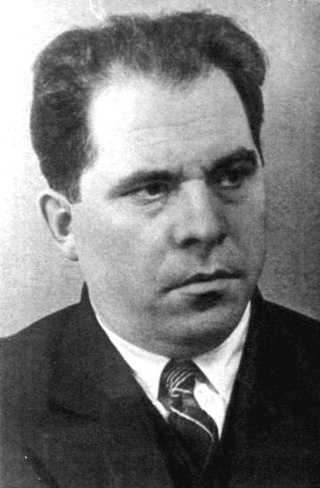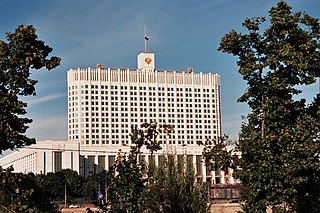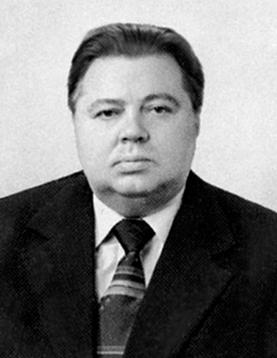| |||||
| Decades: | |||||
|---|---|---|---|---|---|
| See also: | |||||
Events from the year 1909 in Russia .
| |||||
| Decades: | |||||
|---|---|---|---|---|---|
| See also: | |||||
Events from the year 1909 in Russia .
| | This section needs expansion. You can help by adding to it. (July 2016) |
| | This section needs expansion. You can help by adding to it. (July 2016) |
| | This section needs expansion. You can help by adding to it. (July 2016) |

Arseny Grigoryevich Zverev was a Soviet and Russian politician, economist and statesman whose career spanned the rules of Joseph Stalin and Nikita Khrushchev, but culminated during the Stalin years. Zverev was born in a little village just outside Moscow. After years in local politics, he rose to prominence as a Deputy Commissar of Finance, but he also held other lesser posts such as a member of the Supreme Soviet of the Soviet Union.

The flag of the Turkmen Soviet Socialist Republic was adopted by the Turkmen SSR on August 1, 1953. Although similar to the Flag of the Soviet Union, the layout is identical to the flag of the Kirghiz SSR with a ratio of 1:2. The two blue stripes between the red represents the rivers Amu Darya and Syr Darya, the red represents the "revolutionary struggle of the working masses", the hammer and sickle represents the peasants' and workers' union, and the red star is the symbol of the ruling Communist Party.

Ivan Stepanovich Silayev was a Soviet and Russian politician. He served as Prime Minister of the Soviet Union through the offices of chairman of the Committee on the Operational Management of the Soviet economy and chairman of the Inter-republican Economic Committee. Responsible for overseeing the economy of the Soviet Union during the late Gorbachev era, he was the last head of government of the Soviet Union, succeeding Valentin Pavlov.

The Presidium of the Supreme Soviet was a body of state power in the Union of Soviet Socialist Republics (USSR). The presidium was elected by joint session of both houses of the Supreme Soviet to act on its behalf while the Supreme Soviet was not in session. By the 1936 and 1977 Soviet Constitution, the Presidium of the Supreme Soviet served as the collective head of state of the USSR. In all its activities, the Presidium was accountable to the Supreme Soviet of the USSR.

The Order of the Red Star was a military decoration of the Soviet Union. It was established by decree of the Presidium of the Supreme Soviet of the USSR of 6 April 1930 but its statute was only defined in decree of the Presidium of the Supreme Soviet of the USSR of 5 May 1930. That statute was amended by decrees of the Presidium of the Supreme Soviet of the USSR of 7 May 1936, of 19 June 1943, of 26 February 1946, of 15 October 1947, of 16 December 1947 and by decree No 1803-X of 28 March 1980.

Vasily Fyodorovich Garbuzov was a Soviet economist and politician. He served as Minister of Finance from 1960 until his death in November 1985.

The Chairman of the Council of Ministers of the Soviet Union was the head of the government of the Soviet Union during the existence of the Council of Ministers of the Soviet Union from 1946 to 1991.

The Supreme Soviet of the Russian SFSR, later Supreme Soviet of the Russian Federation, was the supreme government institution of the Russian SFSR in 1938–1990; in 1990–1993 it was a permanent legislature (parliament), elected by the Congress of People's Deputies of the Russian Federation.

The Government of the Soviet Union, formally the All-Union Government of the Union of Soviet Socialist Republics, commonly abbreviated to Soviet Government, was the executive and administrative organ of state in the former Soviet Union. It had four different names throughout its existence; Council of People's Commissars (1923–1946), Council of Ministers (1946–1991), Cabinet of Ministers and Committee on the Operational Management of the National Economy. It also was known as Workers-Peasants Government of the Soviet Union during the Stalin era.

The Ministry of Justice of the Union of Soviet Socialist Republics (USSR), formed on 15 March 1946, was one of the most important government offices in the Soviet Union. It was formerly known as the People's Commissariat for Justice abbreviated as Наркомюст (Narkomiust). The Ministry, at the All-Union (USSR-wide) level, was established on 6 July 1923, after the signing of the Treaty on the Creation of the USSR, and was in turn based upon the People's Commissariat for Justice of the Russian Soviet Federative Socialist Republic (RSFSR) formed in 1917. The Ministry was led by the Minister of Justice, prior to 1946 a Commissar, who was nominated by the Chairman of the Council of Ministers and confirmed by the Presidium of the Supreme Soviet, and was a member of the Council of Ministers.
Aleksander Ansberg was an Estonian politician. He was a member of the Communist Party of Estonia.

Lev Alekseyevich Voronin was a Soviet and Russian official. He served as a First Deputy Chairman of the Council of Ministers, literally the Vice-Premier of the Soviet Union, from 1989 to 1990. Responsible for the "general issues" of the cultural and economic administration of the Soviet Union during the late Gorbachev Era, Voronin became acting Chairman of the Council of Ministers in between Nikolai Ryzhkov's hospitalization and Valentin Pavlov's election as Prime Minister. Voronin worked as a banker following the dissolution of the Soviet Union.
Vladimir Makarovich Velichko is a Soviet official and entrepreneur appointed as the First Deputy Prime Minister of the Cabinet of Ministers in 1991.

The Council of People's Commissars of the Soviet Union was the highest collegial body of executive and administrative authority of the Soviet Union from 1923 to 1946.

The Council of Ministers of the Union of Soviet Socialist Republics, was the de jure government of the Union of Soviet Socialist Republics (USSR), comprising the main executive and administrative agency of the USSR from 1946 until 1991.

The Premier of the Soviet Union was the head of government of the Union of Soviet Socialist Republics (USSR). Twelve individuals held the post. Among the most known are Vladimir Lenin and Joseph Stalin.
The following lists events that happened during 1988 in the Union of Soviet Socialist Republics.
Events from the year 1994 in Russia.

Kirill Fyodorovich Ilyashenko was a Moldavian politician who served as the Chairman of the Presidium of the Supreme Soviet of the Moldavian SSR from 1963 to 1980. He served the longest as Chairman of the Presidium, serving a total of 17 years.
![]() Media related to 1909 in Russia at Wikimedia Commons
Media related to 1909 in Russia at Wikimedia Commons